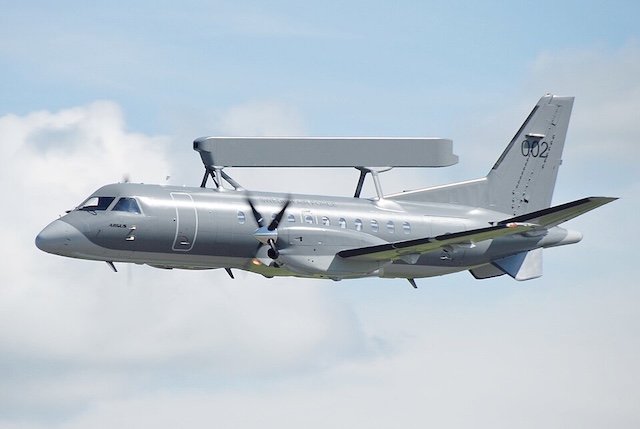Saab 340 AEW&C
Summary
| Category | Military Special Mission Aircraft |
| Origin country | 🇸🇪 Sweden |
| Manufacturer | Saab |
| First flight | 1 January 1994 |
| Year introduced | 1997 |
| Number produced | 12 units |
Description
Developed as a Swedish airborne early warning and control (AEW&C) platform, the Saab 340 AEW&C is a military variant of the Saab 340 regional airliner. Manufactured by Saab AB, the aircraft was designed to provide an advanced surveillance and control capability. It undertook its first flight in 1994 and was formally introduced into service in 1997. Production ran from 1994 until 1999, resulting in a total of 12 aircraft being built. The aircraft is designated S 100B Argus within the Swedish Air Force.
The design of the Saab 340 AEW&C is distinguished by its unique radar system, which eschews a traditional rotating radome. Instead, it utilizes the Erieye system, which features a non-movable, dorsal-mounted PS-890 Active Electronically Scanned Array (AESA) radar. This fixed radar offers reduced aerodynamic drag but creates blind zones directly forward and aft of the aircraft, providing a 120-degree field of view on each side. Operating at an altitude of up to 6,100 meters, the radar is capable of tracking aircraft, missiles, and ships at ranges between 300 and 400 kilometers. The aircraft is powered by two General Electric CT7-9B turboprop engines and has an operational endurance of over five hours.
The Saab 340 AEW&C has seen service with several air forces globally. The Swedish Air Force initially operated six aircraft, four of which were dedicated AEW&C platforms, while two were configured for transport roles in peacetime. In 2006, two of the Swedish aircraft were upgraded to the Saab 340 AEW-300 standard for enhanced surveillance and compatibility with multinational operations. The platform has also been operated by the Royal Thai Air Force and was formerly loaned to the Hellenic Air Force. The United Arab Emirates retired its fleet in 2020 after acquiring the GlobalEye platform. In 2023, Poland purchased two ex-UAE aircraft, receiving them in 2024. In May 2024, Sweden announced the transfer of two ASC 890 aircraft to the Ukrainian Air Force.
Main Variants
- Saab 340B AEW / S 100B Argus (FSR-890): This variant, equipped with the Erieye radar system, serves as the basis for the aircraft supplied to the Thai Air Force.
- Saab 340B AEW-200 (IS-340): A designation for a variant fitted with the Erieye airborne early warning radar system.
- Saab 340B AEW-300 / S 100D Argus (ASC-890): An upgraded version for the Swedish Air Force with enhanced capabilities for deployment in multi-national operations.
- B.K.1: This is the official designation for the Saab 340 AEW&C aircraft in service with the Royal Thai Armed Forces.
- Saab 2000: fuselage-stretched variant fitted with Erieye active electronically scanned array radar and associated mission systems.
Technical specifications
| Version: Saab 340 AEW&C | |
|---|---|
| Crew | 6 |
| Operational range | 1,300 km (808 mi) |
| Endurance | 5 hours |
| Maximum speed | 522 km/h (324 mph) |
| Wing area | 42 m² (452.1 sqft) |
| Wingspan | 21.4 m (70.3 ft) |
| Height | 7.0 m (22.9 ft) |
| Length | 20.6 m (67.5 ft) |
| Service ceiling | 7,620 m (25,000 ft) |
| Empty weight | 10,300 kg (22,708 lbs) |
| Max. takeoff weight | 13,155 kg (29,002 lbs) |
| Climb rate | 10.2 m/s (33.5 ft/s) |
| Powerplant | 2 x General Electric CT7-9B delivering 1390 kW each |
Current operating countries
| Country | Units | ||
|---|---|---|---|

|
Pakistan | 13 | |

|
Thailand | 7 | |

|
Sweden | 3 | |

|
Poland | 2 | |

|
Saudi Arabia | 2 | |

|
Ukraine | 0 (+2) | |
